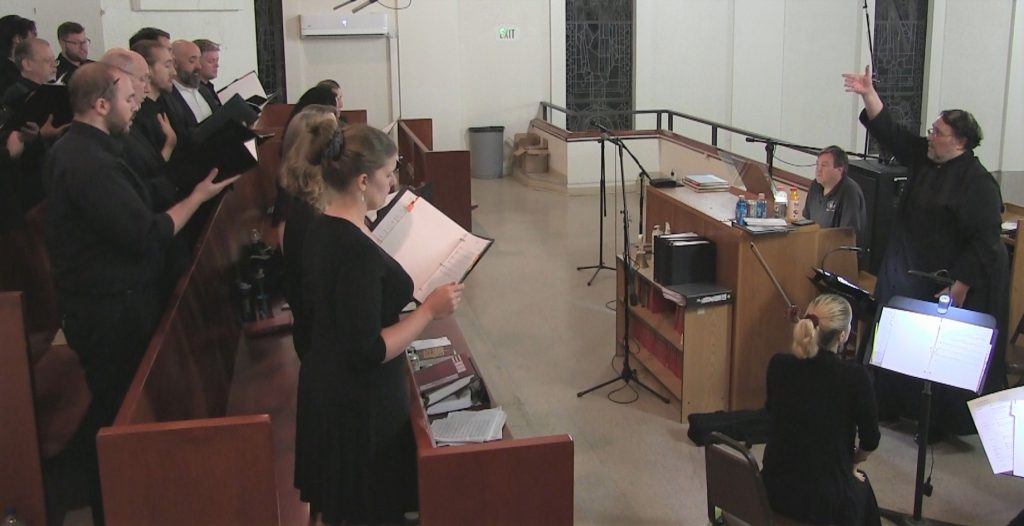Traditionally, the teaching of U.S. history bears a markedly Eurocentric and East Coast character — perhaps understandable, given the country’s founding on the East Coast by descendants of largely European settlers.
So too the teaching of music, again, owing to the heavily European-based composer influence in the time of the Founding Fathers.
And yet, in the late 18th century — the age of Washington, Jefferson, Haydn, Mozart and Beethoven — there was serious (and seriously remarkable) musical development taking place on the other side of the New World, made possible by not only the region’s colonizers and evangelizers, but by the indigenous people themselves.
This was the music of the California Missions, music that Steven Ottomanyi is bringing to San Gabriel Mission, the first mission founded in the present-day Archdiocese of Los Angeles.
On June 29, Ottomanyi, director of music at St. John Chrysostom Church, Inglewood, will conduct the 16-voice Chorus Angelorum and the 18-member California Mission Sinfonia in “Mission Echoes,” featuring music of the Mission era, in a free 7 p.m. concert.
By every account, Ottomanyi said, “the indigenous people of our state had the greatest aptitude for European musical instruments, and often produced musical performances of great artistry. And yet, even a music major who studied in a university in this state would not be taught about this music — mostly because it is all but unknown in most history textbooks, even those focusing on the history of music in the United States.”
Thus, for Ottomanyi, the founder and artistic director of both Chorus Angelorum and the Mission Sinfonia, the program is important culturally as well as artistically, especially in appreciating how California’s indigenous peoples offered much more than blood and sweat in building the missions.
“Of course, I hope to give the audience a good show,” he said with a smile. “But my deeper purpose is to increase awareness of our own native genius in music.”
Ottomanyi is admittedly sensitive to issues involving immigrants and native peoples. He is a native Angeleno born to a Hungarian immigrant father (who fought against the Soviets in the 1956 uprising) and a mother of Native American, Mexican, and Irish heritage, and developed his own interest in music and missions as a youth attending St. Matthias Church in Huntington Park.
“I recall sitting in church, looking at the choir and the organist,” he said, “and I always wanted to be part of that. I’ve always known and felt a vocation to music, especially music in church.”
His mother, meanwhile, took him on trips to visit the missions, “and I began to wonder, ‘These are churches; what did they sing hundreds of years ago?’ But access years ago to information that might have offered a clue wasn’t readily available. To me, it was a mystery that cried out to be investigated.”
Focusing on music, and particularly the study of cantus (chant), Ottomanyi earned a B.A. in music history and theory at Cal State Fullerton, pursued graduate studies in Musicology, and for 25 years has directed choirs and played the organ in southeast LA County parishes, coming to St. John Chrysostom in 2012. But his passion for mission music remained.
He contacted Craig H. Russell, music history professor at Cal Poly San Luis Obispo and author of “From Serra to Sancho: Music and Pageantry in Calif Missions,” a 2010 Edna Kimro Award-winning work that explored sacred music produced on the West Coast while it was under Spanish and Mexican rule.
“Professor Russell noted that the walls of the California Missions resounded with the sounds of classical choir and orchestra comprised largely of indigenous children and directed by friars,” said Ottomanyi. “It consisted of a variety of styles, some common to contemporary European sacred music, some quite unique to the Missions.
“But all of this is our musical heritage, something worth knowing about. And this repertoire finds its roots in the music of Renaissance, Baroque, and Classical Mexico.”
Russell also sent Ottomanyi a black and white manuscript that contained music from the mission era, when ensembles often included violins, a cello and maybe a double bass.
“I was struck by how it was notated, oddly familiar in some ways with very antique looking, square and rhomboid-shaped notes like those from the Renaissance,” Ottomanyi said. “But there were some strange things about it, instances where the bass line sat above the tenor line, or even the alto line, for long stretches. Musically, it made no sense to me.”
Further study, though, suggested that “some transposition needed to take place,” he explained. “Once I realized that, it began to make sense and fall into place.”
The first half of the June 29 concert at San Gabriel Mission will feature Antecedent music from the Renaissance, Baroque and Classical periods — “music written in Mexico by Mexicans,” he pointed out. Selections include Juan Gutiérrez de Padilla’s “Ave Regina Cælorum” and Ignacio de Jerusalén’s “Mass in D Major.”
After intermission, the choral and instrumental ensembles will perform music of indigenous California and the missionaries. “I’ve researched the instrumentation, and looked at the models used by the composers and musicians of the era to know how to perform these in concert as originally intended,” Ottomanyi said.
The event is also Ottomanyi’s graduate recital toward completing his Master of Music in choral conducting at Cal State Los Angeles, a few miles from San Gabriel Mission. He has been accepted to the Ph.D program at Claremont Graduate University, where he will study musicology and linguistics.
“It is my wish, he said, “that students from elementary school through college will be taught about our unique musical heritage — wishful thinking, perhaps. But a start must be made somewhere and sometime.”
Mike Nelson is the former editor of The Tidings (predecessor of Angelus News).
Start your day with Always Forward, our award-winning e-newsletter. Get this smart, handpicked selection of the day’s top news, analysis, and opinion, delivered to your inbox. Sign up absolutely free today!

